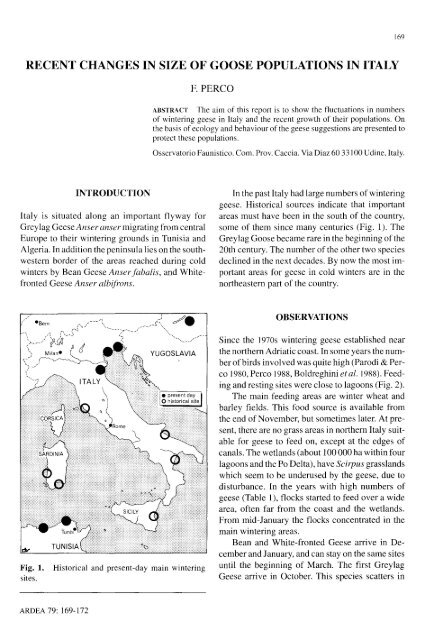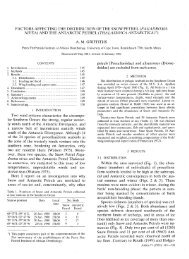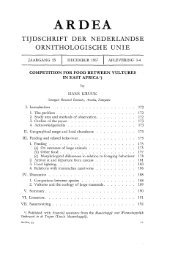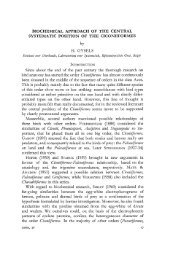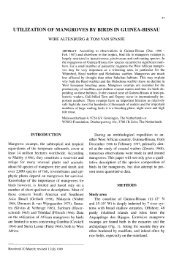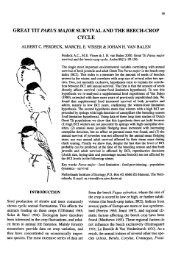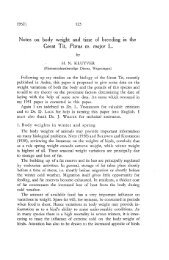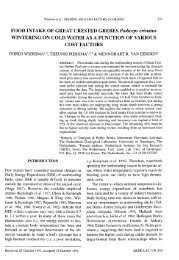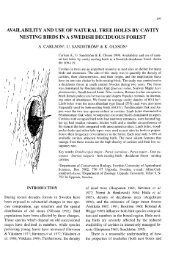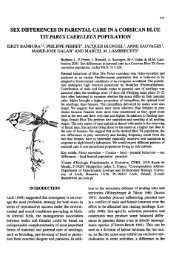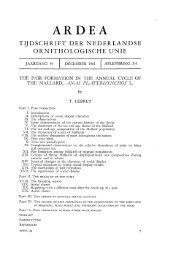recent changes in size of goose populations in italy - ardeajournal ...
recent changes in size of goose populations in italy - ardeajournal ...
recent changes in size of goose populations in italy - ardeajournal ...
Create successful ePaper yourself
Turn your PDF publications into a flip-book with our unique Google optimized e-Paper software.
RECENT CHANGES IN SIZE OF GOOSE POPULATIONS IN ITALY<br />
INTRODUCTION<br />
Italy is situated along an important flyway for<br />
Greylag Geese Anser anser migrat<strong>in</strong>g from central<br />
Europe to their w<strong>in</strong>ter<strong>in</strong>g grounds <strong>in</strong> Tunisia and<br />
Algeria. In addition the pen<strong>in</strong>sula lies on the southwestern<br />
border <strong>of</strong> the areas reached dur<strong>in</strong>g cold<br />
w<strong>in</strong>ters by Bean Geese Anserfabalis, and Whitefronted<br />
Geese Anser albifrons.<br />
F. PERea<br />
169<br />
ABSTRACT The aim <strong>of</strong> this report is to show the fluctuations <strong>in</strong> numbers<br />
<strong>of</strong> w<strong>in</strong>ter<strong>in</strong>g geese <strong>in</strong> Italy and the <strong>recent</strong> growth <strong>of</strong> their <strong>populations</strong>. On<br />
the basis <strong>of</strong> ecology and behaviour <strong>of</strong> the geese suggestions are presented to<br />
protect these <strong>populations</strong>.<br />
Osservatorio Faunistico. Com. Provo Caccia. Via Diaz 6033100 Ud<strong>in</strong>e, Italy.<br />
YUGOSLAVIA<br />
Fig. 1. Historical and present-day ma<strong>in</strong> w<strong>in</strong>ter<strong>in</strong>g<br />
sites.<br />
ARDEA 79: 169-172<br />
In the past Italy had large numbers <strong>of</strong>w<strong>in</strong>ter<strong>in</strong>g<br />
geese. Historical sources <strong>in</strong>dicate that important<br />
areas must have been <strong>in</strong> the south <strong>of</strong> the country,<br />
some <strong>of</strong> them s<strong>in</strong>ce many centuries (Fig. 1). The<br />
Greylag Goose became rare <strong>in</strong> the beg<strong>in</strong>n<strong>in</strong>g <strong>of</strong>the<br />
20th century. The number <strong>of</strong> the other two species<br />
decl<strong>in</strong>ed <strong>in</strong> the next decades. By now the most important<br />
areas for geese <strong>in</strong> cold w<strong>in</strong>ters are <strong>in</strong> the<br />
northeastern part <strong>of</strong> the country.<br />
OBSERVATIONS<br />
S<strong>in</strong>ce the 1970s w<strong>in</strong>ter<strong>in</strong>g geese established near<br />
the northern Adriatic coast. In some years the number<br />
<strong>of</strong>birds <strong>in</strong>volved was quite high (Parodi & Perco<br />
1980, Perco 1988, Boldregh<strong>in</strong>i etal. 1988). Feed<strong>in</strong>g<br />
and rest<strong>in</strong>g sites were close to lagoons (Fig. 2).<br />
The ma<strong>in</strong> feed<strong>in</strong>g areas are w<strong>in</strong>ter wheat and<br />
barley fields. This food source is available from<br />
the end <strong>of</strong> November, but sometimes later. At present,<br />
there are no grass areas <strong>in</strong> northern Italy suitable<br />
for geese to feed on, except at the edges <strong>of</strong><br />
canals. The wetlands (about 100 000 ha with<strong>in</strong> four<br />
lagoons and the Po Delta), have Scirpus grasslands<br />
which seem to be underused by the geese, due to<br />
disturbance. In the years with high numbers <strong>of</strong><br />
geese (Table I), flocks started to feed over a wide<br />
area, <strong>of</strong>ten far from the coast and the wetlands.<br />
From mid-January the flocks concentrated <strong>in</strong> the<br />
ma<strong>in</strong> w<strong>in</strong>ter<strong>in</strong>g areas.<br />
Bean and White-fronted Geese arrive <strong>in</strong> December<br />
and January, and can stay on the same sites<br />
until the beg<strong>in</strong>n<strong>in</strong>g <strong>of</strong> March. The first Greylag<br />
Geese arrive <strong>in</strong> October. This species scatters <strong>in</strong>
170 ARDEA 79 (2),1991<br />
Fig. 2. Goose w<strong>in</strong>ter<strong>in</strong>g areas along the coasts <strong>of</strong>upper<br />
Adriatic sea <strong>in</strong> Italy; ma<strong>in</strong> sites (large circles).<br />
Table 1. Peak numbers along the Adriatic coast <strong>in</strong> Italy.<br />
small groups over many sites. The location <strong>of</strong> the<br />
sites differs between years. Usually the <strong>goose</strong><br />
flocks forage dur<strong>in</strong>g the day and fly to the roosts<br />
at nearby lagoons after sunset. In some areas, however,<br />
especially when the disturbance level is high,<br />
flocks may forage dur<strong>in</strong>g the night and rest <strong>in</strong> protected<br />
areas dur<strong>in</strong>g the day.<br />
S<strong>in</strong>ce 1984 attempts are made to re<strong>in</strong>troduce the<br />
Greylag Goose as a breed<strong>in</strong>g bird <strong>in</strong> Italy. By now<br />
two flocks <strong>of</strong>about 50 birds each stay at "Valle Cavanata"<br />
<strong>in</strong> the prov<strong>in</strong>ce <strong>of</strong> Gorizia and at Marano<br />
lagunare <strong>in</strong> the prov<strong>in</strong>ce <strong>of</strong> Ud<strong>in</strong>e. Some <strong>of</strong> these<br />
birds reproduced successfully. More <strong>recent</strong>ly, similar<br />
flocks have been released <strong>in</strong> other prov<strong>in</strong>ces.<br />
The presence <strong>of</strong>small numbers <strong>of</strong>Red-breasted<br />
Geese <strong>in</strong> w<strong>in</strong>ter has been <strong>recent</strong>ly established. Besides<br />
there were sight<strong>in</strong>gs <strong>of</strong>a few Barnacle Geese,<br />
one Brent Goose, and some Canada Geese.<br />
years 79 80 81 82 83 84 85 86 87 88<br />
Greylag Goose<br />
A 10 100 25 10 110 200 105 370<br />
B 30 300 5 20 50 20 250 100 40<br />
C 100 25 20 5 50 210 250 500 30<br />
total 40 500 30 65 65 180 660 455 910 30<br />
Bean Goose<br />
A 250 1900 250 430 10 170 750 200 2750 50<br />
B 300 2700 550 500 200 150 750 200 1500 200<br />
C 500 2000 700 250 200 360 500 300 1300 60<br />
total 1050 6600 1500 1180 410 680 2000 700 5550 310<br />
White-fronted Goose<br />
A 50 500 20 70 60 750 280 2750<br />
B 100 1500 50 70 40 30 750 200 2000 300<br />
C 50 150 50 50 50 80 200 200 700 50<br />
total 200 2150 120 190 90 170 1700 680 5450 350<br />
sum<br />
totals 1290 9250 1650 1435 565 1030 4360 1835 11910 690<br />
A: Friuli - Venezia Giulia; B: Veneto; C: Emilia - Romagna. Years: 79 =w<strong>in</strong>ter 1977-78.
DISCUSSION<br />
The shift <strong>of</strong> the w<strong>in</strong>ter<strong>in</strong>g areas, especially those<br />
<strong>of</strong> Bean and White-fronted Geese, from southern<br />
Italy to the north might be expla<strong>in</strong>ed by differ<strong>in</strong>g<br />
levels <strong>of</strong> disturbance. Shoot<strong>in</strong>g geese is prohibited<br />
<strong>in</strong> Italy, yet shoot<strong>in</strong>g is obviously the most serious<br />
factor and w<strong>in</strong>ter<strong>in</strong>g flocks concentrate <strong>in</strong> a few<br />
sites. Shoot<strong>in</strong>g ban has less or no effect when hunt<strong>in</strong>g<br />
on other species is still allowed.<br />
Whereas the Italian pen<strong>in</strong>sula covers only some<br />
marg<strong>in</strong>al parts <strong>of</strong> the w<strong>in</strong>ter quarters <strong>of</strong> Bean and<br />
White-fronted Geese, thousands <strong>of</strong> Greylag Geese<br />
pass Italy twice a year. Recent evidence shows that<br />
there are still suitable areas for a reasonable number<br />
<strong>of</strong> w<strong>in</strong>ter<strong>in</strong>g Greylags. This develop<strong>in</strong>g habit may<br />
be promoted by the establishment <strong>of</strong> a network <strong>of</strong><br />
refuges.<br />
ACKNOWLEDGEMENTS<br />
I wish to thank the follow<strong>in</strong>g persons for their help with<br />
this paper: G. Arveda, R. Castellani, B. Dentesani, F. Genero,<br />
R. Parodi, M. Passarella, R. Raffo, P. Utmar, M.<br />
Zanetti. Thanks also to Ann Hill, Paul Tout and Johan<br />
GEESE IN ITALY 171<br />
van Rhijn for their assistance with the english translation<br />
and review <strong>of</strong> the manuscript.<br />
REFERENCES<br />
Boldregh<strong>in</strong>i P., L. Cas<strong>in</strong>i & R. Tnarelli 1988. Lo svernamenlO<br />
delle oche nell' area delle Valli di Comacchio.<br />
In: Spagnesi, M. & S. Toso (eds.). Atti 1° Convegno<br />
nazionale dei biologi della selvagg<strong>in</strong>a. Supp!.<br />
Ricerche di Bio!. d. Selvagg<strong>in</strong>a, Bologna XIV: 51-76.<br />
Parodi R. & F. Perco 1980. Le popolazioni di Anser<br />
fabalis (Lathum 1787), Anser albifrons (Scopoli<br />
1769) e Anser anser (L<strong>in</strong>neus 1758), svernanti nel<br />
Friuli-Venezia Giulia e Veneto orientale. Gortania<br />
- Atti Museo Friu!. Storia Nat. Ud<strong>in</strong>e. 2:221-250.<br />
Pereo F. 1988. Problemi di conservazione e gestione<br />
degli Anseriformi <strong>in</strong> Italia. In: Spagnesi M. & S.<br />
Toso (eds.). Atti jO Covegno nazionale dei biologi<br />
della selvagg<strong>in</strong>a. Supp!. Ricerche di Bio!. d. Selvagg<strong>in</strong>a,<br />
Bologna. XIV: 19-50.<br />
SAMENVATTING<br />
Dit artikel geeft aan welke verander<strong>in</strong>gen er op lange<br />
(Fig. I) en korte termijn (Tabel I) zijn opgetreden <strong>in</strong> aantallen<br />
en gebieden van overw<strong>in</strong>terende ganzen <strong>in</strong> Italie,<br />
die thans vooral aan de noordkust van de Adriatische Zee<br />
liggen (Fig. 2). Besproken wordt verder op welke wijze<br />
de overw<strong>in</strong>terende populaties besehermd kunnen worden.
172 ARDEA 79 (2), 1991<br />
Bean Goose (photo Roel van Beek - RIN).


